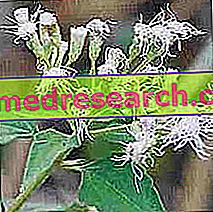What are
What are baby kiwis?
That of baby kiwi - or mini kiwi, if you prefer - is a particular type of gooseberry that produces very small fruits.

From a nutritional point of view, mini kiwis belong to the VII fundamental group of foods - fruits and vegetables rich in vitamin C. In the context of their belonging together, they have a medium energy supply, mainly provided by soluble-simple carbohydrates (fructose ). They contain significant amounts of water and certain minerals - especially potassium.
From the botanical point of view of the witty species, that of the baby kiwi belongs to the Actinidiaceae Family and the Genus Actinidia, or the same as the "traditional" kiwi - that is the most widespread in Italy. The subspecies - sometimes referred to as simply varieties - are mostly marketed: arguta ( A. Arguta arguta ), giraldii and hypoleuca .
The mini kiwis ripen in the autumn season, with small differences due to the climate and the territory. The fruits are grouped into 4-5 units at a time and the bunches remain at a distance of about 10 cm from each other - the harvest is therefore generally very abundant.
Compared to the most commercialized kiwis, the mini kiwis are smooth - with no superficial down - green to brown, red or purple when ripe; more or less the size of a walnut. In fact, if it were not for the slightly more elongated shape - longitudinal ellipse section - the fruit of the baby kiwi would be almost identical to an unripe walnut. The plant is totally different; it is a climber that reaches a maximum size of 6-10 m, even if in agriculture it is normally maintained at a height that makes the harvest of the fruits practical.
The flavor of the baby kiwi is characteristic and the taste is mainly sweet, with acidulous notes however developed - still unripe, the fruit tends to appear; completely ripe, the texture is slightly softer and the taste more intense than other kiwi species. It is suitable for consumption raw and has no particular indications or contraindications; the absence of hair is appreciable, which makes it perfectly edible even with peel.
Did you know that ...
Despite the fact that in the northeastern USA baby kiwis have been cultivated for a long time, in the last thirty years, due to their excessive and rampant growth, in western Massachusetts, Coffin Woods, Long Island, New York, are instead considered weeds.
Nutritional Properties
Nutritional properties of baby kiwis
As mentioned above, baby kiwis are classified in the VII fundamental group of foods - fruits and vegetables rich in vitamin C (ascorbic acid).
Compared to the average of the fruits consumed in Italy, the mini kiwis have a medium caloric intake. Energy is supplied mainly by carbohydrates, followed by low amounts of proteins and irrelevant lipids. Carbohydrates consist entirely of fructose - simple, soluble, monosaccharide sugar. Peptides have a low biological value, ie they do not contain - in the right quantities and proportions - the same essential amino acids of the human protein model. Fatty acids are, in theory, predominantly unsaturated.
Baby kiwis contain dietary fiber, a part of which is soluble in water. Free of cholesterol, they do not even contain the molecules mainly responsible for the main scientifically diagnosable food intolerances, such as gluten, lactose and histamine. It should however be emphasized that all kiwis - such as pineapple, papaya, mango and banana - contain actinidain / actinidine (enzyme cysteine protease), a potentially allergenic molecule; the kiwi is correlated with a cross reactivity towards the latex. The mini kiwis are poor in phenylalanine and purines although we remember that any nutritional excess of fructose can promote a retention of uric acid in the body.
As for vitamins, baby kiwis boast excellent concentrations of ascorbic acid (vitamin C); the contribution of other water-soluble and fat-soluble vitamins is marginal. With regard to mineral salts, on the other hand, the level of potassium should be especially noticeable.
Did you know that ...
Kiwi seeds, on the other hand, have a totally different nutritional profile. Generally they are not chewed thoroughly, so they do not affect the chemical contribution of the fruit. It is however good to remember that from their pressing we obtain an oil rich in omega three polyunsaturated fatty acids (alpha linolenic acid) and vitamin E.
There is a fair concentration of non- vitamin phytotherapeutic molecules, in particular antioxidant polyphenols and beneficial for metabolism - especially for lipemia.

| Baby Kiwi Without Peel | |
| Nutritious | Quantity' |
| water | 84.60 g |
| Protein | 1.20 g |
| Lipids | 0.60 g |
| Saturated fatty acids | - g |
| Monounsaturated Fatty Acids | - g |
| Polyunsaturated Fatty Acids | - g |
| Cholesterol | 0.0 mg |
| TOT Carbohydrates | 9.0 g |
| Starch / Glycogen | tr |
| Soluble Sugar | 9.0 g |
| Food fiber | 2.2 g |
| Soluble | 0.78 g |
| Insoluble | 1.43 g |
| Power | 44.0 kcal |
| Sodium | 5.0 mg |
| Potassium | 400.0 mg |
| Iron | 0.5 mg |
| Football | 25.0 mg |
| Phosphorus | 70.0 mg |
| Magnesium | 12.0 mg |
| Zinc | - mg |
| Copper | - mg |
| Selenium | - mcg |
| Thiamine or vitamin B1 | 0.02 mg |
| Riboflavin or vitamin B2 | 0.05 mg |
| Niacin or vitamin PP | 0.4 mg |
| Vitamin B6 | - mg |
| folate | - μg |
| Vitamin B12 | - μg |
| Vitamin C or Ascorbic Acid | 85.00 mg |
| Vitamin A or RAE | - RAE |
| Vitamin D | - μg |
| Vitamin K | - μg |
| Vitamin E or Alpha Tocopherol | - mg |
Diet
Baby kiwi in the diet
Baby kiwi fruits, like most foods in this category, lend themselves to most diets. Being moderately sugary and energetic, they have few contraindications even in the case of overweight, type 2 diabetes mellitus and hypertriglyceridemia. Obviously, in this case - especially in more severe clinical pictures - it is advisable to reduce the average portion and frequency of consumption so as to be able to comply with the indications for adequate food therapy.
The dietary fibers of mini kiwis perform numerous beneficial functions for the body. First and foremost, properly associated with water - of which these fruits are rich - the fibers can:
- increase the mechanical stimulus of satiety - even if fructose is a carbohydrate that weakly triggers the hormonal feedback of satiety
- modulate nutritional absorption - reducing the insulin glycemic surge and hindering the absorption and reabsorption of cholesterol and bile salts
- prevent or treat constipation / constipation. Note : the kiwi is attributed strong laxative functions, even partially independent of the dietary fiber content.
This latter aspect contributes to decreasing the chances of carcinogenesis of the large intestine and of many other discomforts such as hemorrhoids, anal fissures and anal prolapse, diverticulosis and diverticulitis, etc. Note : in the past it was believed that solid, non-chewable residues could trigger inflammation of intestinal diverticula; the kiwi, in this case, contains many small seeds. However, the latest research suggests that the major causes of diverticulitis are of another kind; among others, for example, a diet low in dietary fiber and constipation.
It should also be remembered that soluble fibers constitute a nutritional substrate for intestinal bacterial flora; maintaining the trophism of the microbiota, whose metabolism releases important nutritional factors for the mucosa, further promotes the health of the colon.
Vitamin C and polyphenols have an important antioxidant role. In addition to counteracting the action of free radicals - guilty of cellular aging - these nutritional elements are considered useful in the treatment of various metabolic pathologies.
The richness of water and potassium contributes to improving the hydro-saline balance, which is especially precarious with the increase in sweating, and also supports the therapy of primary arterial hypertension. Water and minerals are two nutritional factors often lacking even in the elderly.
The baby kiwi is to be avoided, logically, in case of food allergy; this can manifest itself in various ways but the most widespread form simply involves a localized skin reaction - many times, hypersensitive subjects are not even aware of it.
There are no contraindications for the conditions of: celiac disease, lactose intolerance, histamine intolerance and phenylketonuria; it is instead advised not to overdo it, respecting frequency of consumption and normal portions, in case of hyperuricemia or gout - as we have already said, it is known that too much fructose in the diet can aggravate the retention of uric acid.
Baby kiwis have no limitations in the vegetarian, vegan and raw food diet; the same applies to philosophies and / or religions of all kinds.
The average portion of baby kiwi is 100-200 g (about 40-80 kcal).
Kitchen
Baby kiwi in the kitchen
The baby kiwis are eaten mostly raw, at full maturity, even without peeling them. With these fruits an excellent jam is also produced, however not much consumed in Italy.
In Korea these fruits are known as "darae". The young leaves of the plant, called "darae-sun", are consumed as "namul" - side vegetables.
Botany
Notes on baby kiwi botany
The baby kiwi plant is a perennial climbing vine native to Japan, Korea, Northern China and Russian Siberia.
It belongs to the Family Actinidiaceae, Genus Actinidia and witty species. Several subspecies or varieties are cultivated - in this regard the bibliographical sources consulted are not sufficiently accurate - such as: the argute ( A. arguta arguta ), the giraldii and the hypoleuca . The most popular cultivars are: Ananasnaya, Geneva, MSU ", Weiki, Jumbo Verde and Rogow. The Japanese cultivar Issai (A. arguta × rufa) is a self-fertile hybrid.
Cultivation
Notes on baby kiwi cultivation
The mini kiwi plant is a very resistant fast-growing climber - hence the English name "hardy kiwi" - and is able to survive at low temperatures - even much below 0 ° C. Like most fruit plants, even the baby kiwi has more sensitive buds to spring frosts.
These plants need a frost-free vegetative season of about 150 days; they do not appear to be damaged by late frosts, provided that the temperature variations are sufficiently gradual to allow acclimatization. On the contrary, a period of winter cold is necessary to obtain an abundant harvest.
The baby kiwis can be grown directly from the seeds - germination time is about a month - or by cutting, even directly grafted onto the rootstock.
In domestic cultivation, horizontal growth can be encouraged by using poles; this will allow a more convenient maintenance and collection. Note : these plants grow very quickly and require solid pylons for their support. In ideal conditions, each plant can grow up to 6 meters per season.
Plants can tolerate even partial shade, but the yield is optimal in full sun exposure. Mini kiwis consume large amounts of water; therefore, they are usually grown in acid and well-drained soils to prevent root rot.



